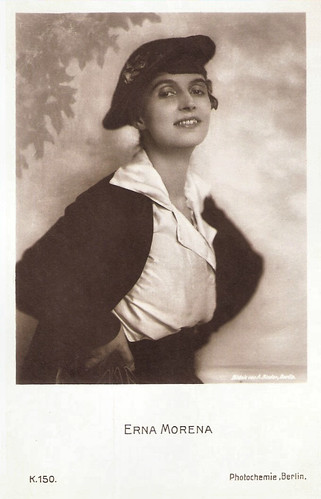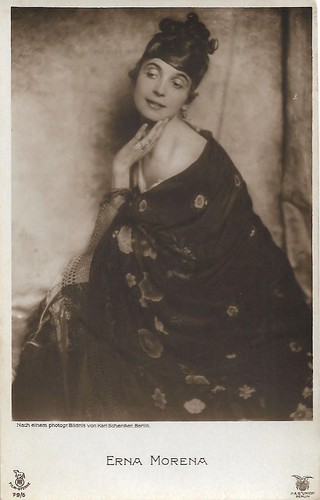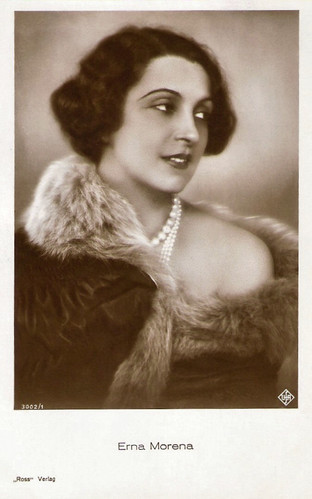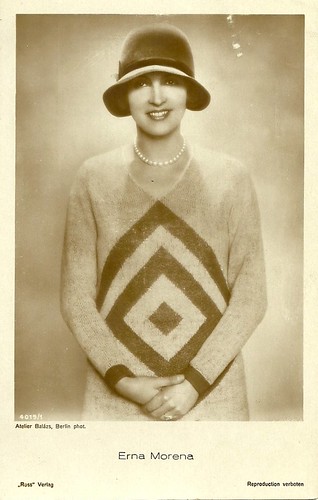
German postcard by Messter Film GmbH. Photo: Schenker, 1914.

German postcard by NPG, no. 280. Photo: A. (Alex) Binder, Berlin.

German postcard in the Moderne Künstler series by MMB, no. 463. Photo: F.J. Wesselsky.

German postcard by Photochemie, Berlin, no. K. 1740. Photo: Alex Binder, Berlin.

German postcard by Ross Verlag, no. 1060/1, 1927-1928. Photo: Atelier Balázs, Berlin.
Bewildered by her subtle performance
Erna Morena was born Ernestine Maria Fuchs in a bourgeois family in Wörth am Main, Germany, in 1885. At the age of 17, she went to München (Munich) to attend the Kunstgewerbeschule (art school). Later, she spent six months in Paris, until finally at the end of the first decade she moved to Berlin and worked there as a nurse.
In 1910, Morena started her acting career at the Schauspielschule des Deutschen Theaters (the acting school of the German Theatre) and swiftly got an engagement at the Ensemble Max Reinhardt.
She made her film debut in 1913. Her first film was Sphynx/The Sphinx (Eugen Illés, 1913), and she went on to play in several more dramas by Eugen Illés for the Duskes company.
In 1914, she moved to the Messter Film company, where she appeared with Emil Jannings and Theodoor Loos in Arme Eva/Poor Eva (Robert Wiene, 1914) and with Hella Moja in Die weiße Rose/The White Rose (Franz Hofer, 1915).
From 1915 to 1921 she was married to editor and stage author Wilhelm Herzog, who had also invented her stage name, Erna Morena. All her Messter-films were distributed under the trademark of 'Erna Morena Film Serie', rivalling the series of Asta Nielsen and Henny Porten.
Around 1917 she moved to PAGU, where she starred in an adaptation of Franz Wedekind's play 'Lulu' (Alexander Antalffy, 1917) opposite Harry Liedtke and Emil Jannings, and in Paul Leni's Prima Vera (Paul Leni, 1917), based on Alexandre Dumas, fils' 'La Dame aux camélias' (Camille). Critics were bewildered by her subtle performance.
Morena also dabbled as a producer: in 1918 she founded Erna Morena Film GmbH in Berlin, supported by some friends as partners. She produced films like Colomba (Arzén von Cserépy, 1918) with Werner Krauss, and Die 999. Nacht/The 999th Night (Fred Sauer, 1920) with Hans Albers. Because of the economic crisis after the German November Revolution of 1918-1919, she had to stop producing after two years.

German postcard by Photochemie, Berlin, no. K. 150. Photo: Alex Binder, Berlin.

German postcard by Photochemie, Berlin, no. K. 1982. Photo: Union Film. Erna Morena in Prima Vera (Paul Leni, 1917).

German postcard by Photochemie, Berlin, no. K. 1986. Photo: Union-Film. Erna Morena in Rafaela/Wer weiss? (Arsen von Cserépy, 1917).

German postcard by Photochemie, Berlin, no. K. 1990. Photo: Union Film. Erna Morena, Emil Jannings and Harry Liedtke in Der Ring der Giuditta Foscari (Alfred Halm, 1917).

German postcard by Photochemie, no. K. 2923. Photo: Erna Morena-Film. Erna Morena in Die 999. Nacht/The 999th night (Fred Sauer, 1920).

German postcard by NPG, no. 257. Photo: Alex Binder, Berlin.
Her long neck and dark looks
Erna Morena was one of the most unusual stars of silent German cinema. Dark-haired, tall, and with distinctive facial features, she had a star appeal as later Greta Garbo had.
Morena was most successful with her films by director Richard Oswald in the late 1910s and early 1920s, such as Das Tagebuch einer Verlorenen/Diary of a Lost Woman (Richard Oswald, 1918) a forerunner of the version by Georg Wilhelm Pabst, and the horror film Nachtgestalten/Figures of the Night (1920) starring Paul Wegener.
She also starred in some classic Expressionist films including Nerven/Nerves (Robert Reinert, 1919), Von morgens bis Mitternacht/From Morn to Midnight (Karl Heinz Martin, 1920) with Ernst Deutsch, and Der Gang in die Nacht/The Dark Road (F.W. Murnau, 1921) with Olaf Fönss and Conrad Veidt.
With her long neck and dark looks she often played exotic beauties, as in Die Lieblingsfrau des Maharadscha, 3./The Favourite Wife of the Maharajah (Max Mack, 1921), and Das Indische Grabmal, 1. and 2./The Indian Tomb (Joe May, 1921), but also regal beauties in historical dramas as Fridericus Rex 1., 2., 3. and 4. (Arzén von Cserépy, 1922-1923) with Otto Gebühr, Wallenstein 1. and 2. (Rolf Randolf, 1925), Bismarck 1. and 2. (Ernst Wendt, 1925), and Das Schicksal derer von Habsburg/The destiny of the Habsburgs (Rolf Raffé, 1928) in which she played Empress Elisabeth - Sissi.
Of course there were also contemporary set stories like Der Berg des Schicksals/The Mountain of Destiny (Arnold Fanck, 1924) with Luis Trenker, the film that inspired Leni Riefenstahl to pursue a career in film; Mutter und Kind/Mother and Child (Carl Froehlich, 1924); Man spielt nicht mit Liebe/One Does Not Play with Love (G.W. Pabst, 1926) starring Werner Krauss and Lili Damita; Grand Hotel (Johannes Guter, 1927) with a script by Bela Balazs, and Somnambul/The Somnambulist (Adolf Trotz, 1929) with Fritz Kortner.
She also played in one Dutch film, De bruut/The brute (1922) directed by Theo Frenkel, who had an active career in Germany in the 1920s, and in the French film Le fauteuil 47/ Chair no. 47 (Gaston Ravel, 1926) with Dolly Davis.

German postcard in the Film Sterne series by Rotophot, no. 529/2. Photo: Richard Oswald-Film. Erna Morena in Das Tagebuch einer Verlorenen/The Diary of a Lost Woman (Richard Oswald, 1918), based on the homonymous novel (1905) by Margarete Böhme. In 1929, G.W. Pabst would film another adaptation, starring Louise Brooks, while already in 1912 an earlier adaptation by Fritz Bernhardt had taken place.

German postcard by Photochemie, no. K. 1738. Photo: Alex Binder, Berlin.

German postcard by Photochemie, no. K. 1739. Photo: Alex Binder, Berlin.

German postcard by Photochemie, no. K. 1741. Photo: Alex Binder, Berlin.

German postcard by Ross Verlag, Berlin, no. 34/1. Photo: Ass-Film, Berlin. Erna Morena and Maria Forescu in the German silent film Götz von Berlichingen zubenannt mit der eisernen Hand (Hubert Moest, 1925), an adaptation of Goethe's historical play set in medieval times. Morena played the countess Ravenstein and Forescu a farmer's wife.

German postcard by Ross Verlag, no. 42/3. Photo: Karl Schenker / Bismarck-Film. Erna Morena as Johanna von Bismarck, née Puttkamer in the German biopic Bismarck, Teil. 1 (Ernst Wendt, 1925). Signed by Erna Morena.
Her heydays were over
Erna Morena seems to have made the passage to sound cinema quite smoothly as there was no big arrest in her number of film roles.
Still, from the young star and protagonist of the films of the late-1910s and early 1920s she had to be satisfied now with playing mothers, secondary roles. Her heydays were over.
Among her more interesting films of this period are Das Lied der Nationen/The Song of the Nations (Rudolf Meinert, 1931) with Camilla Horn, Eine Nacht im Paradies/A Night in Paradise (Carl Lamac, 1932) starring Anny Ondra, Drei Kaiserjäger/Three Imperial Light Infantrymen (Franz Hofer, Robert Land, 1933), and the operetta Abschiedswalzer/Farewell Waltz (Géza von Bolváry, 1934).
In the mid-1930s, she opened a pension for artists in München (Munich), and only returned to the film set for small parts in a handful of films, including the notorious Jud Süss (Veit Harlan, 1940).
After the war, she appeared in only one film, Veit Harlan's Unsterbliche Geliebte/Eternal Beloved (1951), an emblematic title as the film meant Morena's goodbye.
One decade later, Erna Morena died in München, in 1962. Between 1913 and 1951 she had appeared in about 120 films. She had a daughter, Eva-Maria Herzog.
In 2006 filmmakers Bettina Neuhaus and Natasja Giebels made a poetic film portrait about the life story and personality of Erna Morena, Schwarzer Schwan/Black Swan.

German postcard in the Film Sterne Series by Rotophot, no. 79/2. Photo: Karl Schenker, Berlin / P.A.G. Union.

German postcard in the Film Sterne Series by Rotophot, no. 79/5. Photo: Karl Schenker, Berlin / P.A.G. Union. Collection: Didier Hanson.

German postcard in the Film Sterne Series by Rotophot, no. 79/6. Photo: Karl Schenker, Berlin / P.A.G. Union.

German postcard by Ross Verlag, Berlin, no. 311/2, 1919-1924. Photo: Wasow, München (Munich). Erna Morena and her daughter.

German postcard by Ross Verlag, no. 3002/1, 1928-1929. Photo: Ufa.

German postcard by Ross Verlag, no. 3423/1, 1928-1929. Photo: Atelier Balázs, Berlin.

German postcard by Ross Verlag, no. 4019/1, 1929-1930. Photo: Atelier Balazs, Berlin.
Sources: Thomas Staedeli (Cyranos), Filmportal.de, Wikipedia (German), and IMDb.
No comments:
Post a Comment